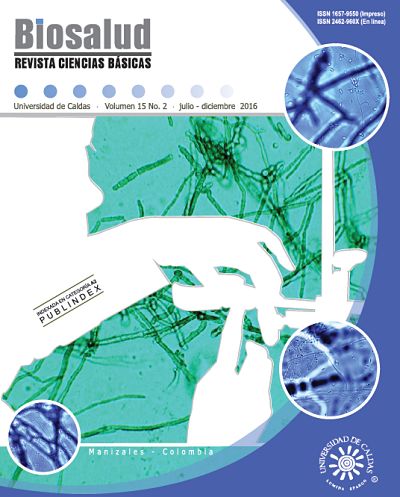Authors
Abstract
Objective: To evaluate the diagnostic ability of presepsin, procalcitonin and C-reactive protein (CRP) biomarkers in septic patients in intensive care units in Santa Marta (Colombia). Materials and Methods: Case-control studies, biomarker determination, was made by analytical methods. The discriminant ability of different markers was valued by using the area under the ROC curve. Results: Of the patients diagnosed with sepsis, 55% had negative blood cultures, and 45% were positive. In this study the area under the curve (AUC) for presepsin was 0.996; for procalcitonin was 0.709, and for CPR was 0.607. With a significance level of 0.05, presepsin showed a p-value of 0.006; procalcitonin showed a value of 0.084 and C-reactive protein showed a value of 0.23. Conclusions: It was determined that presepsin is the best biomarker for early diagnosis of sepsis.
References
2. Pallas L. Interleukina 6. Valor pronóstico de mortalidad y fracaso multiorgánico en el paciente crítico. [Tesispara la obtención del grado de doctor en Medicina y Cirugía]. Valencia:
Universidad de Valencia. 2013
3. Siqueira R, Gomes A, Calixto L, Vitorino R, Castro M, Gomes E, et al. Sepsis: una actualización. Rev Bras Ter Intensiva 2011; 23:207-216
4. Azkárate L, Sebastián R, Cabarcos E, Choperena G, Pascal M, Salas E. Registro observacional choque severa sepsis / séptico prospectivo en un hospital de tercer nivel en la provincia de Guipúzcoa. España. Med Intensiva. 2012; 36:250-256
5. Valverde Y. Fundamentos epidemiológicos, fisiopatológicos y clínicos de la sepsis en la población infantil. MEDISAN 2011; 15:1156-1165
6. León C, Loza A. Biomarcadores en la sepsis. ¿Simplificando lo complejo? Enferm Infecc Microbiol Clin. 2014; 32:137–139
7. Jiménez A. Biomarcadores de infección en urgencias: ¿cuáles pueden sernos útiles? España. Emergencias 2012; 24:343-345
8. Londoño J, Niño C, Hoyos N, Jaimes F. Uso de biomarcadores en el diagnóstico temprano y el tratamiento de la sepsis. IATREIA. 2013; 26: 457-466
9. Bayarri M, Casanoves E, Pallás E, Sancho S, Martín L,Tormo C et al. Valor pronóstico de los biomarcadores, procalcitonina interlukina 6 y proteína C reactiva en la sepsis grave. Med intensiva 2012; 36: 556-562.
10. Vélez Lab. Presepsin, biomarcador ideal en el diagnóstico de sepsis, Identificación rápida y fiable de los pacientes en riesgo. Perú. Monografía. 2011.
11. Ministerio de Salud. Resolución Nº 008430 de 1993.Colombia. Disponible en http://www.unisabana.edu.co/fileadmin/Documentos/Investigacion/comite_de_etica/Res__8430_1993_-_Salud.pdf Consultado Marzo de 2016]
12. Shozushima T, Takahashi G, Matsumoto N, Kojika M, Okamura Y, Endo S. Usefulness of presepsin (sCD14- ST) measurements as a marker for the diagnosis and severity of sepsis that satisfied diagnostic criteria of systemic inflammatory response syndrome. J Infect Chemother 2011; 17:764-9
13. Masson S, Caironi P, Spanuth E, Thomae R, Panigada M, Sangiorgi G, et al. “Presepsin (soluble CD14 subtype) and procalcitonin levels for mortality prediction in sepsis: data from the Albumin Italian Outcome Sepsis trial.” Critical Care 2014, 18:2-9
14. Spanuth E, Ebelt H, Ivandic B, Werdan K. Diagnostic and prognostic value of presepsin (soluble CD14 subtype) in emergency patients with early sepsis using the new assay PATHFAST Presepsin. 21st International Congress of Clinical Chemistry and Laboratory Medicine, IFCC-WorldLab – EuroMedLab p. 15-19 May 2011
15. Zhang X, Liu D, Liu Y, Wang R, Xie L. The accuracy of presepsin (sCD14-ST) for the diagnosis of sepsis in adults: a meta-analysis. Critical Care 2015; 19: 323
16. Carpio R, Zapata J, Spanuth E, Hess G. Utility of presepsin (sCD14-ST) as a diagnostic and prognostic marker of sepsis in the emergency department. Clin Chim Acta 2015; 450:169-75.
17. Manti, A. Biomarcadores en neumonías. Rev Am Med Resp 2010; 10:21-35.
18. Sánchez R, Becerra G, Grajales L, Canseco L. Frecuencia de microorganismos aislados de hemocultivos en un hospital de tercer nivel en el estado de Chiapas. Enf Inf Microbiol 2010; 30: 53-58
19.Tong X, Cao Y, Yu M, Han Ch. Presepsin as a diagnostic marker for sepsis: evidence from a bivariate meta-analysis Ther Clin Risk Manag 2015; 11:1027–1033.
20. Chenevier-Gobeaux C, Trabattoni E, Roelens M, Borderie D, Claessens YE. Presepsin (sCD14-ST) in emergency department: the need for adapted threshold values? Clin Chim Acta 2014; 427:34-6.
21. Endo S, Suzuki Y, Takahashi G, Shozushima T, Ishikura H, Murai A, et al. Usefulness of presepsin in the diagnosis of sepsis in a multicenter prospective study.J Infect Chemother 2012; 18:891–7

 pdf (Español (España))
pdf (Español (España))
 FLIP
FLIP


















